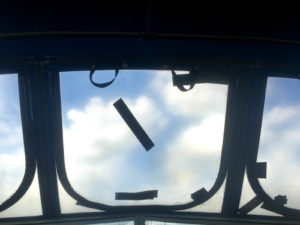Canvas repairs—turning pain into profit
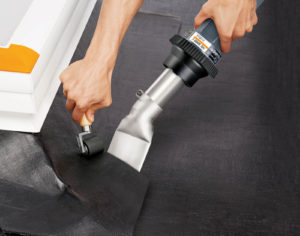
Fabricators who do repairs may need to be adept at using a variety of tools. A heat gun, like this one from Steinel America Inc., can come in handy when the repairs involve weldable material. Photo: Steinel.
Let’s go out on a limb here and make this proclamation: Repair jobs are not the sexiest work in the marine fabrication business.
Okay, maybe that’s not so much of a limb. The fact is, some fabricators try to stay away from repair work altogether or consider it something of a necessary evil. They’ve got bigger fish to fry.
However, there are those fabricators who have embraced repairs. They have figured out how to make the work profitable and often use it as an opportunity to deepen the relationship with their customers and build their business.
Take, for example, Scott Massey, owner of Awning Cleaning Industries, a company that despite its name does significant business in marine fabric work from its 17,000-square-foot facility in New Haven, Conn.
“So many places prefer not to do repairs anymore, or don’t have the ability to do repairs, that when we decided to start doing them our shop went from 0 to 60 in about three seconds,” says Massey, who employs two full-time sewers who spend 10 months of the year doing repairs from other fabricators. The work includes restitching, braid repairs, patching, zipper repairs, snap, fastener and grommet repair and replacement, as well as work on enclosures.
Charlene Clark, who with her husband, Chandler Clark, owns Signature CanvasMakers in Hampton, Va., says repair jobs aren’t the most profitable work in her shop and can take away from bigger tasks. But that doesn’t mean her company turns away repair business.
“When our workload is fully committed,” says Clark, “we’ll cut off repairs for a period of time so our team can stay focused on our larger jobs. Rather than turning people away, we place them on a ‘deferred repair list.’ When we have an opening, we call them to bring the repair in.”
Broc Wodzien, who runs Grand Traverse Canvas Works in Traverse City, Mich., says repair work accounts for about 10 percent of his business. He says he tries to maximize efficiency by encouraging boat owners to have necessary repair work done when a boat is being pulled out of the water for the season.
“We try to educate people to add repairs to their service list, or to have us look things over and do spot repairs,” says Wodzien. “We tell people to have that work done when they are putting things away; it’s better than when they’re trying to take the boat back out.”
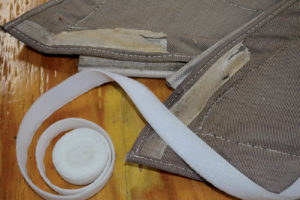
The marine environment is tough on fabric, including hook and loop fasteners that need to be replaced when they get torn, dirty and wear out. This example comes from Awning Cleaning Industries. Photo: Awning Cleaning Industries.
Why repairs are necessary
Most of the reasons marine fabrics need repairs should not come as a surprise.
“You’re dealing with soft goods in a pretty taxing environment,” says Wodzien. “Sun, rain, wind and even ice and hail abuse the stitching and the fabric. Then you add natural airborne stuff like sap and pollen, all the gunk that falls out of trees, and things begin to look dingy or fall apart. It’s Mother Nature coming to bear.”
“If you’re using your boat on a country lake, things can last a long time,” adds Massey. “But if your boat is docked near a city airport or a highway, in three years you may not be able to see through the enclosures and materials are breaking down. Petroleum-based pollution is so heavy in those areas. It can be a dirty world out there.”
The impact of nature at work can be somewhat mitigated by regular cleaning and maintenance, according to Massey. He says one of his customers got twelve years of use from a boat cover because he took care of it, while another with the same cover brought it in for repairs after seven years because he hadn’t done much to keep it clean or protected.
But repairs can also be needed for other reasons. “Generally, our most challenging repairs come from working with canvas that was initially made using inferior products and shortcut techniques,” says Clark.
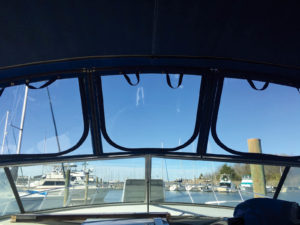
Customers may need to be educated on the repair process so they understand why jobs cost what they do, says Charlene Clark of Signature CanvasMakers, which did the work on this enclosure. Photo: Signature CanvasMakers.
How to estimate
Repairs themselves can sometimes be a challenge, but so can figuring out exactly what to charge for them. Standard price lists, used by some fabricators but not all, only go so far.
“After 30 years in the industry, I can pretty much look at a job and figure out how many hours I’m going to have, either in repair or replacement,” says Steve Griffith, owner of Marine Tops Unlimited in Madison, Wis. “I don’t post a repair price list because every job is different.”
“We have some standardized pricing for simple things, but most jobs are going to vary in size and complexity, as well as materials,” explains Wodzien.
Signature CanvasMakers sets prices for certain types of repairs, such as replacing zippers and clear vinyl, says Clark. “Other repairs, such as restitching, patching and modifications, are estimated on a per-hour basis,” she says. “For those types of jobs, we provide a broad range to clients—‘We anticipate this taking one to two hours unless we find any unexpected issues once we begin the work.’
“We know what we need to charge to do repairs in order to not lose money,” she says. “But customers often don’t understand what it takes to repair canvas (‘It’s just a little repair; it can’t take you that long!’). We make sure that we educate them on the process so they can better understand the cost and the labor that is involved.”
When a repair is not worth doing
“For example, if someone brings us a full cover and the entire middle is shredded, the fabric is threadbare and the stitching is deteriorated, we would advise them that the cover is not worth repairing,” says Clark. “For the number of hours it would take us to reconstruct that cover, their money would be better spent in investing in a new one.
“We will always try to do what’s best for the customer,” she adds. “Sometimes what’s best is to not waste their money on repairing something that isn’t going to hold up regardless of what we do to try to fix it.”
“If something is going to cost half as much to repair compared to the price of going new, it’s probably not worth the fix,” says Griffith. “You might only get a year out of a repair, as opposed to 10 or 15 years with something new.”
When the price is wrong
The biggest issue in repairs may come when the original estimate turns out to be off the mark. Different fabricators handle that predicament in different ways.
“Most of the time when that happens, it’s our fault,” says Massey. “If we’re not good enough to know, I might call a customer and let them know and if they’re open to it, there might be some sort of increased charge on it, but 99 percent of the time when I give a price, that’s the price.
“We told the customer the price and they agreed,” he adds. “I don’t like having to call someone to tell them I can’t do the job at the price I said.”
At Massey’s shop those repairs might actually be considered something of a “loss leader” because of the amount of repair work Awning Cleaning Industries does. “If I was only doing four jobs a week, I might be upset when we estimate wrong,” says Massey. “But volume graciously covers those kind of scary moments.”
At Signature CanvasMakers, according to Clark, “If the job is far deeper than originally anticipated, we immediately stop, reevaluate and call the customer with an updated estimate before proceeding. We definitely don’t want to waste time continuing if the customer is not willing to pay to have the work done right.”
“It’s frustrating when you significantly underestimate the complexity of something,” says Wodzien. “Sometimes you have to slow yourself down, take a deep breath, pull something out again and look at it with clear, fresh eyes, and make sure you’re not missing anything.
“Just checking in with one other person in the shop might yield a novel solution to a problem and save time,” he adds.
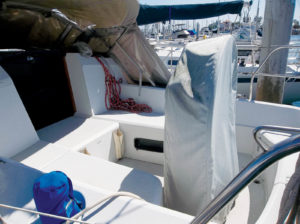
Dirt, mold, sap and debris can make things look dingy over time. Regular cleaning, proper storage and adequate ventilation can somewhat mitigate this. Photo: Harbor Custom Canvas.
Wodzien also looks at industry magazines or online resources such as YouTube to see how other shops may have handled a similar project.
“We’ve gleaned little tips and tricks for different ways of doing things,” says Wodzien, “but ultimately, experience is really valuable. When you’ve been through some doozies, you can identify a hornet’s nest you want to stay out of, or an easy way to do something.
“We typically will stick by our estimates unless we clearly estimated wrong and then we try to address that before we’ve gotten into the project much,” he says. “Otherwise, we look at it as goodwill—just like it’s part of the advertising budget. I gave somebody a valuable repair for less than it should have been, and I can tell them, ‘It was way more challenging than when we estimated it. We’re not going to charge you more, but just so you know there was way more to this.’
“People appreciate you going that extra mile,” he says.
That can lead to more business, as can just doing repairs in general, Clark says: “We have experienced that sometimes small repairs can lead to larger, more profitable jobs.”
In addition, repairs can also provide valuable experience for those employees tasked with doing them. “Repairs serve as an opportunity to train new people on our techniques,” says Clark. “It gets them more comfortable working with larger, bulkier and heavier items.”
Jeff Moravec is a freelance writer from Minneapolis, Minn.
 TEXTILES.ORG
TEXTILES.ORG 


